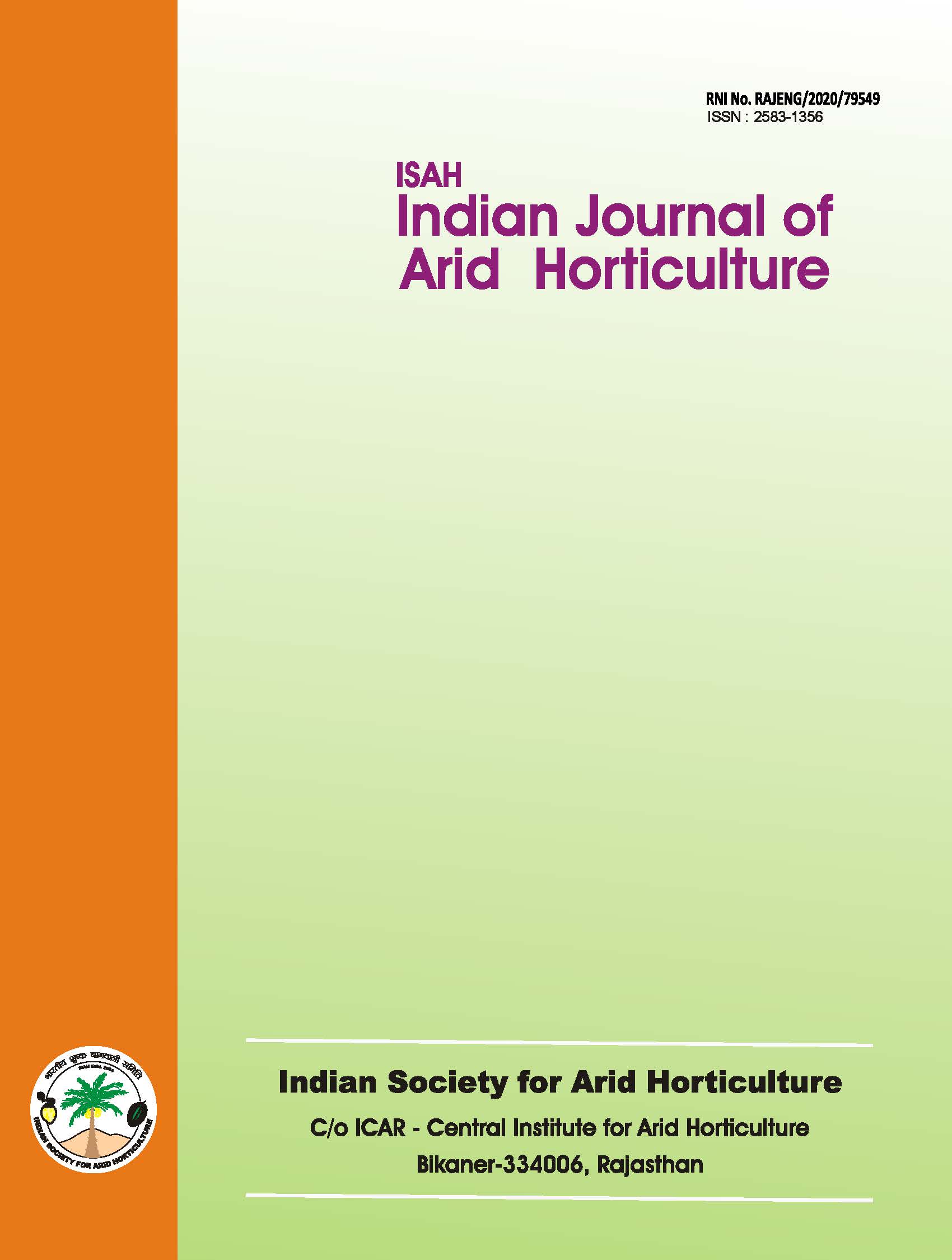Influence of organic manures and bio-fertilisers on yield attributes and economics of kharif onion (Allium cepa L.) in semi-arid region
Keywords:
querctin, Azosprillium, aeration, bio-fertilisersAbstract
Onion (Allium cepa L.) is a bulbous biennial herb of family Alliaceae. It is commonly called as "Queen of kitchen" for its unique usage throughout the year in the form of salads, condiments or for cooking with other vegetables. The pungency in onion is due to sulphur compound "ally propyl disulphide" in the volatile oil and the outer skin colour is due to the presence of "querctin" (Nadkarni, 1954). Onion bulb is rich in minerals like phosphorus (50mg/100g), iron (0.7mg/100g), calcium (18mg/100g), carbohydrates (11.0g/100g), protein (1.2g/100g), vitamins 'C' (11mg/100g), fibers (0.6g/100g) and nicotinic acid (0.4mg/100g) (Aykroyd, 1963). The productivity of onion in India is very low (16tha) in comparison to other countries. Thus there is ample scope for increasing production through fertilizers, especially that of organic manures and bio-fertilsers in light textured soil. Production of onion in kharif season is more important to have continuous supply of onion round the year. Organic manures stimulates the production of polysaccharides and other compounds that favours aggregation of fine soil particles, thereby promoting good structure, improved tilth, aeration, moisture movement and retention (Bose et al., 2001). Bio- fertiliser inoculation like Azosprillium, PSB helps the plants to attain better vegetative growth and increases yield by 10-30 percent (Mohondas, 1999 and Tilak and Annapurna, 1993). The present investigation was taken up to study effect of organic manures and bio-fertilisers on kharif onion in semi arid region.Downloads
References
Arnon, D.I. 1949. Copper enzyme in isolated chloroplast. Polyphenol oxidase in Beta vulgaris. Plant Physiology, 24: 1-5.
Aykrody, W.R. 1963. ICMR. Special Report, Series, No. 42. Barakart, M.A.S. and Gabr, S.M. 1998. Effect of different
biofertilizer and nitrogen fertilizer levels on tomato plant. Alexandria Journal Agril. Reseach., 43: 149- 160. Bose, T.K., Kabir, J., Das, P. and Joy, R.P. 2001. Organic farming in horticulture crops. Tropical Horticulture, 2:20, Publishing Naya Prakash, New Delhi, p.150 Choudhary, R.S., Das, Anchal, Patnaik, V.S. and Das, A. 2003.
Organic farming for vegetable production using vermicompost and FYM in Kokriguda watershed of Orissa. Indian Journal of Soil Science Conservation, 31:203-206.
Fisher, R.A. 1950. Statistical method for research workers.
Oliver and Boyd, Edinburg, London.
Jackson, M.L. 1973. Soil chemical analysis. Prentice Hall of
India Pvt.Ltd., New Delhi, pp.498.
Mengistu F and Singh N, 1999. Vegetable Science, 26, pp. 193-
195.
Mohandas S.1999. Biofertilizer for Horticulture crops. Indian
Horticulture. 43:32-37.
Muthuramalingam S, Natarajan S, Sendurkumaran S and Muthuvel I. 2001. Morphological characters as influenced by spacing and nutrients in seed propagated aggregatum onion (Allium cepa L. var aggregatum Don.) type Gnanamedu local. Madras Agricultural Journal. 88: 379-382.
Nadkarni KN.1954. Allium cepa Linn and Allium sativum Linn. Indian Materia Medica, Popular book depot, Bombay:963.
Paul NB, Rewari RB, Sen A, Sundeao WVB and Bhatnagar RS.1971. Rhizobial inoculation o pulse crops for better yield.Division of microbiology, New vistas in pulse production, IARI, New Delhi, pp-47-56. Ramesh PS, Singh M, Panwar NR, Singh AB and Ramana S. 2006. Response of pigeonpea varieties to organic manures and their influence of fertility and enzyme activity of soil. Indian Journal of Agricultural Science, 76: 252-254.
Sharma RP, Dutt N and Chander G. 2009. Effect of
vermicompost, farm yard manure and chemical fertilizers on yield, nutrient uptake and soil fertility in okra (Abelmoschus esculentus), onion (Allium cepa) sequence in wet temperature zone of Himachal Pradesh. Journal of the Indian Society of Soil Science, 57:3.
Snell PD and Snell GT. 1949. Calorimetric methods of
analysis, 3 End. Vol. II D. Van. Nostrand Co. Inc., New York.
Tabatabi MA and Bremner JM. 1970. A simple turbidimetric
soil. Madras Agriculture Journal, 84: 382-384. method of determining total sulphur in plant Tilak KVBR and Annapurna K. 1993. Bacterial fertilizers. material. Agron. Jouranal, 62: 805-806.
Tanwar SPS, Sharma GL and Chahar MS. 2003. Effect of
phosphorus and biofertilizer on yield, nutrient concentration and uptake by blackgram [Vigna munga (L.) Hepper]. Legume Research, 26: 39-41. Thanunathan K; Natarajan S; Kumar RS and Arul-Murugan
K. 1997. Effect of different sources of organic amendments on growth and yield of onion in mine
Proceeding Indian National Academic Science, 59 (3-4):315-324.
Yeptho KA, Vitoli AK, Singh SP, Kanaujia VB and Singh B. 2012. Quality production of kharif onion (Allium cepa) in response to bio-fertilsers inoculated organic manures. Indian Journal of Agricultural Sciences, 52:2012.

